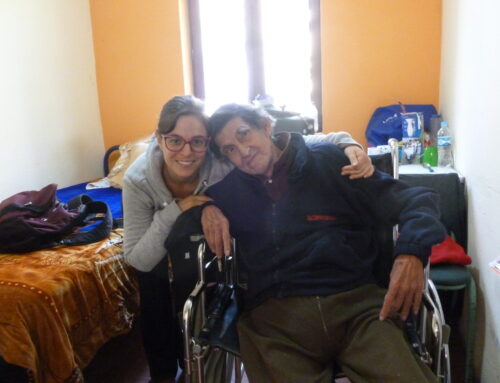
Question posed by a user on r/MaladaptiveDreaming. Photo Credit: Reddit
The YouTube video starts with silence, so heavy that I initially suspected a problem with my speakers. Onscreen, a young woman, Eveleen, sits alone in what looks like a dorm room, fiddling with a small toy, mouthing words I can’t make out. Not until she turns her head, fourteen seconds in, is it apparent that she’s wearing headphones. There is music in the video, it turns out, or at least something other than silence. It’s only the viewer who can’t hear it.
At twenty-two seconds, a camera cut moves Eveleen from sitting to standing, or rather, wandering within the tight space of her room. She continues mouthing words, but the toy is now gone. Instead, she gestures with her hand—to whom or what is unclear to the viewer. She paces back and forth and back again, seemingly content, rapt with internal attention. Yet the title she gives to her video suggests something amiss: “Maladaptive daydreaming caught on camera.”
How can something as common as daydreaming be maladaptive? In 2002, an Israeli psychologist, Eli Somer, coined the term, describing it as an “extensive fantasy activity that replaces human interaction and/or interferes with academic, interpersonal, or vocational functioning” (197). Though maladaptive daydreaming has not (yet) been recognized as a clinical disorder, it has nevertheless been received with enthusiasm on social media platforms such as YouTube, Twitter, Tumblr, TikTok, and Reddit. Users highlight how maladaptive daydreaming can involve positive, negative, or ambivalent daydreams and often features ongoing relations with fictional or fictionalized characters, commonly called paras, in vivid and immersive worlds, commonly called paracosms. They sometimes discuss maladaptive daydreaming through the language of addiction, perceiving themselves compelled to enter and renter their paracosms through sensory triggers—a favorite song, for example—and to pace or otherwise move their bodies while daydreaming. As one daydreamer once told Somer:
When I daydream I often hold an object in my hand, say, an eraser or a marble. I toss in the air. This repetitive monotone movement helps me concentrate on the fantasy. Daydreaming is easier when I do this because I don’t get distracted by other things in the room. At other time I would go down to the basement and pace for hours while daydreaming [2002: 208].
Some folks online recognize their own experiences through the framework of maladaptive daydreaming because they want to stop these experiences, linking them to what they often describe as prior or ongoing trauma. Other people are more ambivalent, debating whether and when daydreaming thwarts ordinary life, and if the thwarting itself is inherently undesirable. As one playfully incredulous TikTok user, @javi_riefkhol, states:
So you’re telling me that all the imaginary scenarios that I play in my head constantly 24/7 is [sic] now a mental disorder? Called maladaptive daydreaming? What?!… And I’m out here thinking what I would do if I had Iron Man’s money and intelligence and resources, and now you’re telling me that’s a mental disorder?!
Perusing social media gives me the impression that many folks who publicly identify as having maladaptive daydreams, or as being maladaptive daydreamers, present as cisgender female, trans, or nonbinary, white, millennial or Gen Z, and as students or employees in precarious economies (including digital ones. Eveleen frames her daydreaming as “caught on camera,” but she knew the camera was on and chose to upload this “found footage”). More recently, Somer has lauded the rising popular reception of maladaptive daydreaming as an empowering “micropolitical process of medicalization—the bottom-up reification of maladaptive daydreaming” (Somer and Bershtling 2018: 1984). In response, the writer Laura Grace Simpkins (2022) questions the ostensibly high prevalence of daydreaming among women, non-binary, and trans people, cautioning that daydreaming may be a “widespread cultural response to being in a marginalized position in the world.” As such, perhaps it ought to be celebrated for fostering community, not diagnosed as maladaptive.1
Anthropologists have paid little, if any, attention to maladaptive daydreaming. Yet anthropologists researching ordinary daydreaming (for lack of a better term) have drawn attention to how liminal relations, spaces, and conditions seem particularly generative for daydreaming. John Borneman (2011), for one, traces how the anthropologist, as a kind of liminal figure, can incite and influence interlocutors’ daydreams. Orvar Löfgren and Bill Ehn (2007), for another, examine daydreaming as a cultural practice through the lens of what in Sweden is called “keeping dusk”—moving through, and thinking with, the transition from light to dark. And Cheryl Mattingly (2010), in her work on children undergoing treatment in what she calls a “clinical borderland,” describes how these children turn to daydreams, or are invited by others to daydream, as part of their treatment. She suggests that “on one hand, there is an imaginative daydreaming that can open up the world of reality by disclosing its possibilities. On the other hand lies an escapist daydreaming that only sedates and confines us…” (2010: 190).
Mattingly’s distinction between opening up the world and being confined by or in it brings to mind Michel Foucault’s well-known lament that “madness will no longer proceed from a point within the world to a point beyond, on its strange voyage; it will never again be that fugitive and absolute limit. Behold it moored now, made fast among things and men. Retained and maintained. No longer a ship but a hospital” (1964 [1961]: 31). The object of his lament is the changing mobility of the mad from the Renaissance to the Classical Age. In the former, the wanderings of the mad at the edges of European society, and the world, came to be associated with a particular sort of wisdom, a testing of the limits of knowledge. In the latter, the confinement of the mad wrested apart madness, reason, and unreason, setting the stage for the medicalization of madness into mental illness in the Modern Age. Watching Eveleen retrace her steps in her room—and film and upload her retracing for anyone, anywhere to see, so long as they have an internet connection—invites the question: is she wandering or is she confined?
That is, I think, a more apt question than a question of “sanity”: in describing her behavior as maladaptive, Eveleen stakes a claim to disorder, not madness or mental illness, and also to the acuity to discern order and disorder in her life. As I scroll through the comments underneath her video, one from a user named Bloomy catches my eye: “This entire place is so comforting”—a reference to this comments section or the internet—“Living ‘in my own world’ has always been the only way to make me genuinely happy, and currently is my main source of entertainment. I can’t imagine my life without this. It feels good to not feel insane.” Yet the more I scroll—on YouTube, Reddit, TikTok, Twitter, Tumblr—the less apt even that question becomes. Rather, the appeal of the framework of maladaptive daydreaming seems to be its integration, not opposition, of comfort and discomfort, community and individuality. It is a form of wandering that confines.
In positing maladaptive daydreaming as an integration of wandering and confinement, I mean this both literally and otherwise. On the literal: many people who identify as maladaptive daydreamers, or as having maladaptive daydreams, frame the compulsion to move their bodies as a possible point of entry into their paracosms. In the words of one Reddit user: “I normally shake my head while lying in bed. What I have found out so far is that bed is a limited and therefore secure space to me. That’s why it’s possible to dive into my fantasy world. When I tried pacing I had difficulties feeling secure as I constantly had to watch out for my steps.” As this comment suggests, pacing is often but not exclusively seen as a key movement of and for maladaptive daydreaming, often accompanied by sensory stimuli like music. For some people, pacing must be done indoors, or even within a specific room or space; others pace familiar outdoor spaces or routes; others still tack between indoors and outdoors as they pace. Regardless of the site of pacing, what often threads together the experiences of folks who associate pacing with maladaptive daydreaming is a sense of the body itself as liminal, a moving mediation between external and internal worlds. As a form of wandering, pacing moves daydreamers less from a point within the world to a point beyond, as Foucault writes, than it does from a point beyond the self to a point within. And—on the otherwise—when they interpret their wandering through the lens of maladaptive daydreaming, it then moves them to the also-liminal world of online community, at once tangible and intangible, infinite and insular. In one Reddit thread, a user (u/randomcarrotaf) notes that pacing “kept me active despite being locked in.” It’s unclear to me what being locked in might mean here; the timing of the post doesn’t match with, say, early COVID lockdowns in some parts of the world. In the same thread, another poster (u/DreamLocomotive) writes—not in response but in parallel—that they “pace 1 2 3 4 turn is 3 as 1 then repeat going the other direction. It’s not helpful as I still get lost.” Once again, it’s unclear to me what getting lost might mean in this case—or what it might mean to be found.
Pacing features in many comments on Eveleen’s video, which are largely supportive of her choice to film herself and the concept of, and community around, maladaptive daydreaming. A user named PikaOMiau notes the following:
I pace too. I listen to music, and I imagine being in [s]cenarios related to the music I’m listening. Sometimes, I’m just the singer, in a music video. Other times, it just triggers other types of fantasies but with music putting me in that mood. I daydream without music too, but more about conversations with people. Alternate versions of past events, or just an alternate way I could live… sadly, it sometimes mixes with real life and I end up believing I can fulfill these fantasies. I wish there was a cure for this. A treatment. But there’s not even an understanding of it… I’m writing this mostly for myself. But thank you for your video. It was very validating… [ellipses and italics mine].
The possibility of alternate ways of living is a driving force behind many things—revolutions, religions, movies where aliens are good, movies where aliens are bad—and certainly not confined to daydreams. But as this comment makes particularly clear, it is the (for-now) unrealized nature of this possibility that can frustrate people who identify with the framework of maladaptive daydreaming. From the vantage of a point within the self, this framework not only offers but insists on the wisdom of a distanced perspective on the world beyond, on- and off-line, and at a degree of distance that feels restrictive to many folks. And so, in the liminal space between the possibility and actuality of an alternate life, between pacing alone to music no one else can hear and filming this pacing for anyone else to see, wandering (if not necessarily madness) is reborn for the 21st century. The internet is both ship and hospital. It is connection.
Notes
[1] A similar view was expressed by a colleague of mine, who read an earlier draft of this essay and suggested that maladaptive daydreaming could be interpreted as the product of “a state in conflict that seeks to extinguish other political imaginaries.”
Acknowledgements
This essay was born as a talk at the 2023 Society for Psychological Anthropology Meeting, on a panel entitled “Dreams, Fantasy, and Anthropological Knowledge in Contexts of Ongoing Violence.” I thank the panelists and audience members who gave feedback on this talk, especially Marios Falaris, Doug Hollan, Talia Katz, Matthew McCoy, and Matthew Newsom. Postcard/thumbnail photo credit: Billy Huynh on Unsplash.
References
Bershtling, Orit, and Eli Somer. 2018. The Micro-Politics of a New Mental Condition: Legitimization in Maladaptive Daydreamers’ Discourse. The Qualitative Report 23(8):1983-2002.
Borneman, John. 2011. Daydreaming, Intimacy, and the Intersubjective Third in Fieldwork Encounters in Syria. American Ethnologist 38(2):234-248.
Foucault, Michel. 1964 [1961]. Madness and Civilization: A History of Insanity in the Age of Reason. New York: Vintage.
Löfgren, Orvar, and Billy Ehn. 2007. Daydreaming Between Dusk and Dawn. Etnofoor 20(2):9-21.
Mattingly, Cheryl. 2010. The Paradox of Hope: Journeys through a Clinical Borderland. Berkeley: University of California Press.
Simpkins, Laura Grace. 2022. Maladaptive Daydreaming, Gender Myths, and Me. Stories: Wellcome Collection. Accessed April 14, 2023. https://wellcomecollection.org/articles/YvylxBAAACMA–Lg.
Somer, Eli. 2002. Maladaptive Daydreaming: A Qualitative Inquiry. Journal of Contemporary Psychotherapy 32:197-212.
Elizabeth Durham holds a joint appointment in the Department of Anthropology and the Society of Fellows at the University of Michigan, Ann Arbor. She earned her PhD in Anthropology from Princeton University in 2022. Her current book project examines the delivery and experience of secular state psychiatry in the Republic of Cameroon, in a period of rising Pentecostal adherence and armed conflict among the Republic and secessionist factions.
Cite As: Durham, Elizabeth. 2023. “21st Century Wanderers’ Club: The Online Rise of Maladaptive Daydreaming”, American Ethnologist Website, 23 May 2023 [https://americanethnologist.org/online-content/essays/21st-century-wanderers-club-the-online-rise-of-maladaptive-daydreaming-elizabeth-durham/]




